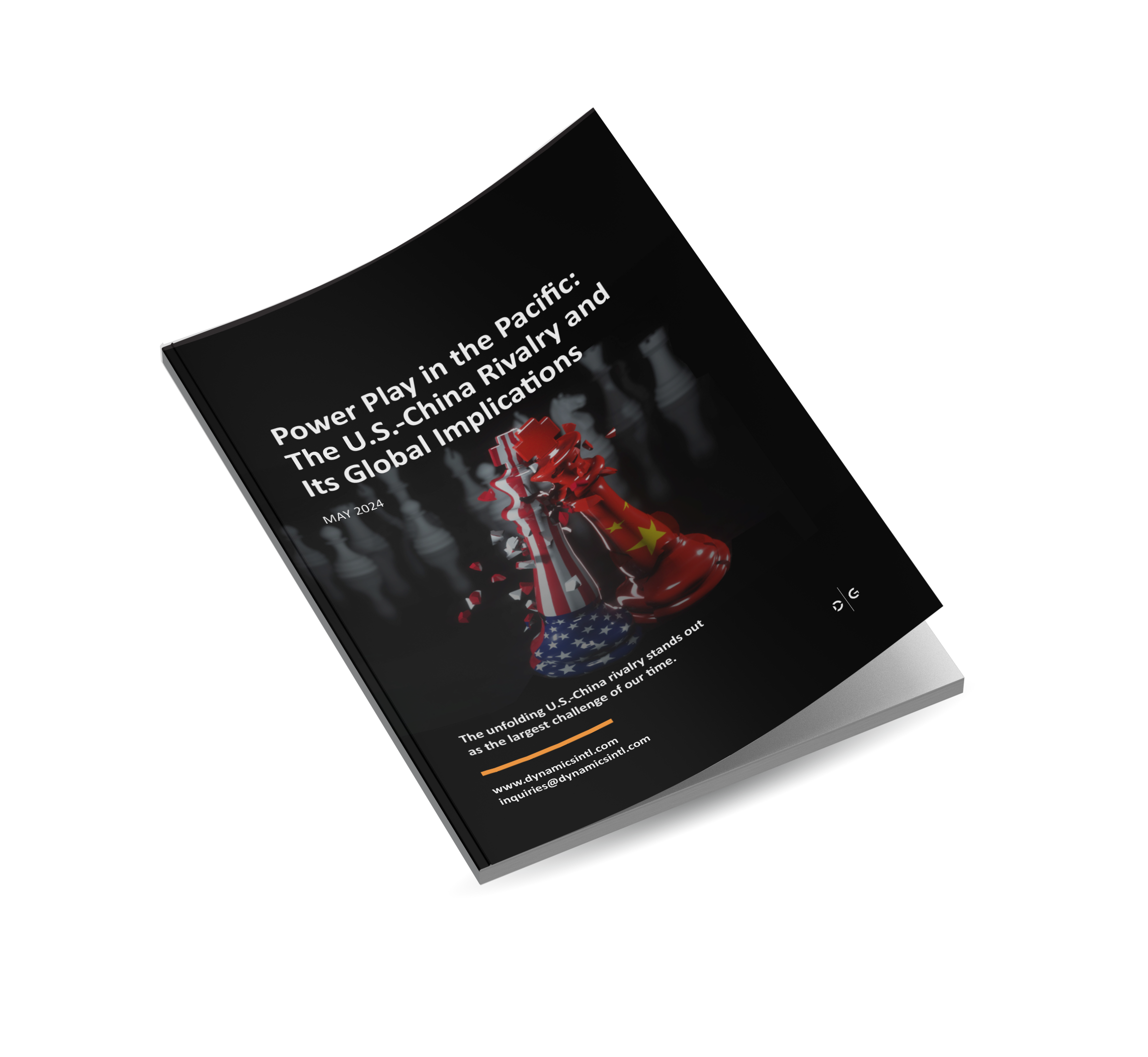Listen to the article – Power Play in the Pacific: The U.S.-China Rivalry and Its Global Implications
- The U.S.-China rivalry in the Indo-Pacific is the most significant global geopolitical issue today.
- Military tensions around Taiwan and the South China Sea could lead to global conflict.
- Economic interdependencies between the U.S. and China shape the global market; disruptions could cause worldwide economic instability.
- Shifting alliances and diplomatic maneuvers are reshaping global power dynamics.
- Technological and cybersecurity competitions will set future global standards for security and innovation.
- The outcome of this rivalry will define the future of international order and global governance.
The world currently faces numerous immediate crises with raging wars rage, terrorist attacks, natural disasters strikes and various diseases threatening humans and animals across the continents.
Yet, beneath these urgent events there are deeper, more enduring strategic issues, which stir the course of history and define the fate of nations. Among these, the unfolding U.S.-China rivalry, perhaps stands out as a single and largest challenge of our time. It is an example of what is called a “grey rhino” — a well-known and high-impact challenge that, despite being widely recognized, has been consistently underreported in the global media.
This particular rivalry is not merely another item on the global agenda. It is a fundamental contest for power, influence, and socio-economic dominance in the 21st century.
How can we help?
Intelligence Solutions
The combination of business, market and strategic intelligence ensures result-driven outcomes for our customers.
Risk management
Risk management through the responsibility of taking risk ownership while ensuring safety and security
The complexity of the U.S.-China relationship encompasses military posturing, economic competition, diplomatic maneuvers, and technological races. Each individual aspect carries significant consequences for the international community ranging from military tensions around Taiwan and in the South China Sea to the economic dependencies that influence global markets.
The following are just a few layers of this complex and multi-dimensional rivalry that are emphasizing its depth and magnitude, which reshape alliances, dictate global economic trends and redefine international security norms. The U.S. and China’s strategic maneuvers in the South China Sea not only involve military posturing but also impact the economic and sovereign rights of neighboring countries, which rely on these waters for trade and resource extraction.
01
Historical Context and Evolution
of the Rivalry
01
Historical Context and Evolution of the Rivalry
The U.S.-China relationship went through significant transformations since the establishment of formal diplomatic ties in 1979. Initially characterized by cooperation in geopolitical and economic spheres, the relationship was formatted for counterbalancing the Soviet influence during the Cold War.
Shortly after, however, the economic interdependencies significantly grew and further expanded in 2001 when China joined the World Trade Organization. This development elevated the magnitude of US investments in Chinese industrial complex, which in turn made China the global factory and powerhouse.
As China became economically stronger and more assertivein geopolitical terms, the strategic dynamics between the U.S. and China began shifting towards competition. The past two decades witnessed rising trade disputes, which some analysts even called the “trade war”.[1] Moreover, concerns over China’s military expansion, human rights record, and its role in global governance led to a reevaluation of policies by the U.S. The so-called “pivot to Asia” strategy initiated by the Obama administration to strengthen the U.S. influence, was a response to China’s growing assertiveness in the Indo-Pacific region.
This trend continued under the Trump presidency and the tensions escalated drastically. The new policy was characterized by a trade war initiated in 2018, significant tariffs on Chinese goods, and a hard stance on issues ranging from technology transfers to the South China Sea disputes. This period became a point of a clear departure from engagement to strategic rivalry between the two countries.
The Biden administration continued to view China as a major strategic competitor, focusing on strengthening alliances within the Indo-Pacific to counterbalance China’s regional ambitions. This includes diplomatic efforts and military cooperation with countries like Japan, Australia, and India, particularly within frameworks like the Quadrilateral Security Dialogue (Quad). And the new strategic AUKUS alliance even positioned itself as a primary tool for keeping in check growing Chinese influence[2] in the world and specifically within the waters of Indian and Pacific oceans.
Current Triggers of Tension
In the most recent time, several key events and policies exacerbated tensions between the U.S. and China:
- Taiwan: Increased military maneuvers by China around Taiwan and heightened U.S. support for Taipei have led to fears of a potential military conflict.[3]
- Trade and Technology: Restrictions on Chinese technology firms and continued tariffs have intensified economic tensions.[4]
- Regional Powerplay: The U.S. has been expressing[5] strong concerns over human rights issues in Xinjiang and Hong Kong. China and its regional ally Russia expressed their own concerns about the United States’ meddling in China’s internal matters, which lead to various diplomatic strains.
- South China Sea: China’s militarization of artificial islands and maritime claims conflict with U.S. freedom of navigation operations, creating frequent tensions.[6]
02
Military and Strategic Dynamics
02
Military and Strategic Dynamics
The Indo-Pacific region has seen significant military expansions by both the U.S. and China. China has modernized its military capabilities extensively, focusing on increasing its naval reach and developing anti-access/area denial (A2/AD) systems.
These systems are designed to prevent adversaries from entering or operating within a specific geographic area, using a combination of missile systems, strategic bases, and surveillance technologies. The U.S. has responded by reinforcing its own military presence and capabilities in the region, including frequent freedom of navigation operations (FONOPs) to challenge China’s maritime claims. The U.S. maintains significant military bases in Japan and South Korea and has increased rotational deployments through alliances with Australia and the Philippines, countering China’s military buildup and claims in the region.
The issue of Taiwan remains critical in U.S.-China relations. China considers Taiwan a part of its territory and has not ruled out the use of force to achieve the “reunification” with mainland China. The U.S., while not having formal diplomatic relations with Taiwan, is bound by the Taiwan Relations Act, which includes providing the island with means to defend itself.
The tension over Taiwan has escalated with the increase of Chinese military exercises[7] around the island and U.S. arms sales[8] to Taipei, raising concerns about a potential conflict that could involve multiple global powers.
Download Report
Power Play in the Pacific: The U.S.-China Rivalry and Its Global Implications
The U.S.-China rivalry in the Indo-Pacific is the most significant global geopolitical issue today.
The U.S. and China’s strategic maneuvers in the South China Sea not only involve military posturing but also impact the economic and sovereign rights of neighboring countries, which rely on these waters for trade and resource extraction.
The U.S. strategy in the Indo-Pacific involves strengthening alliances and forming new partnerships.[9] Key allies like Japan and Australia play strategic roles. Japan hosts U.S. military bases and participates in joint military exercises, serving as a counterbalance to Chinese influence. Australia has increased its defense spending and upgraded its military capabilities, partly in response to China’s assertiveness. Additionally, the Quadrilateral Security Dialogue, involving the U.S., India, Japan, and Australia, focuses on maritime security and ensures a free and open Indo-Pacific. This alliance structure not only enhances military readiness but also serves as a diplomatic signal to China regarding regional resistance to its policies.
03
Economic Impact
03
Economic Impact
The U.S. and China are deeply connected economically representing the world’s largest bilateral trade relationship.[10]
The flow of goods, services, and capital between the two countries has significant implications for the global economy. However, trade tensions break out repeatedly, particularly following the U.S.-China trade war[11] that started in 2018. This conflict saw the imposition of tariffs on billions of dollars worth of goods from both sides, which disrupted international trade patterns and affected global supply chains.
The Indo-Pacific region is absolutely crucial for global supply chains, especially in sectors like electronics, automotive, and pharmaceuticals. The region covers key shipping lanes and major manufacturing hubs.[12] Heightened tensions or conflicts could lead to disruptions in these supply chains, causing delays, increasing costs, and forcing companies to seek alternative supply routes or sources. For example, during the trade war, many businesses began reevaluating and diversifying their supply chains away from China, a process known as “decoupling.” This shift has implications for global trade efficiency and economic stability.
The economic interactions between the U.S. and China significantly affect global markets.[13] It was noted on numerous occasions that stock markets around the world react strongly to news of tariff impositions, trade negotiations, and other economic tensions between the two nations. For instance, announcements of new U.S. tariffs or Chinese retaliatory measures have led to immediate and significant fluctuations in global stock markets, reflecting investor concerns about the broader economic impacts of these policies. To illustrate this, during the initial phase of the U.S.-China trade war in 2018, tariffs on $34 billion worth of Chinese goods led to a direct response from China with equivalent tariffs on U.S. imports. This tit-for-tat tariff imposition resulted in a 13% drop in U.S.-China trade volumes within the following year, underscoring the tangible impact of economic policies on international trade dynamics.[14] Needless to say that the uncertainty[15] caused by these economic conflicts can lead to reduced investment, slower growth, and increased volatility in global financial markets.
04
Diplomatic and Alliance Structures
04
Diplomatic and Alliance Structures
The diplomatic and alliance maneuvers of both the U.S. and China are recalibrating the power dynamics within the Indo-Pacific and significantly impacting global governance structures. As each seeks to expand its sphere of influence, the international community faces new challenges and shifts, which will shape the geopolitical landscape for years to come.
The evolving U.S.-China rivalry has dramatically reshaped diplomatic and military alliances[16] in the Indo-Pacific and beyond. The U.S. has been proactive in reinforcing its traditional alliances and forming new partnerships,[17] a strategy aimed at containing China’s influence.[18] Japan and Australia, as longstanding U.S. allies, have seen a deepening of their military and strategic ties with the U.S. The revival of the Quadrilateral Security Dialogue (Quad), involving the U.S., Japan, India, and Australia, underscores this strategic realignment. This alliance seeks to ensure a free and open Indo-Pacific region, serving as a counterweight to China’s assertive maritime claims and activities.
Furthermore, the U.S. has engaged in new security pacts such as AUKUS, an agreement between the U.S., the UK, and Australia, focusing on advanced defense technologies and nuclear submarine development. This pact not only enhances Australia’s naval capabilities but also serves as a strategic deterrence in the region, signaling a robust allied response to potential threats.
Equally, China engaged in its own vigorous diplomatic initiatives[19] to expand its global influence and counter Western alliances. The Belt and Road Initiative (BRI) remains China’s cornerstone foreign policy, designed to expand its economic and strategic reach through massive investments[20] in infrastructure projects across Asia, Europe, and Africa. By forging economic ties, China aims to pull countries into its orbit, diluting U.S. influence.
How can we help?
Intelligence Solutions
The combination of business, market and strategic intelligence ensures result-driven outcomes for our customers.
Risk management
Risk management through the responsibility of taking risk ownership while ensuring safety and security
In Southeast Asia, China attempted to enforce economic dependencies to split regional consensus within ASEAN. Despite maritime disputes in the South China Sea involving several ASEAN members, China has managed to avoid unified criticism from these nations, partly through diplomatic and economic influence. For the past two decades, countries like Singapore and Indonesia have been conducting very careful diplomatic policies to balance their relationships with both superpowers to their advantage seeking to secure economic benefits while avoiding entanglement in geopolitical conflicts.
The intense rivalry between the U.S. and China is also reshaping global governance.[21] In international forums such as the United Nations, both powers use their veto rights and diplomatic clout to sway decisions and forge blocks of influence that support their geopolitical interests. This rivalry extends to control over international norms and standards, particularly in areas like trade, technology, and human rights.
In economic terms, the rivalry has influenced major economic institutions like the World Trade Organization (WTO), where the U.S. and China spar over trade practices and tariffs. The clash over leadership in these bodies has significant implications for global economic policy and the enforcement of international trade laws.
The competition has also manifested in technological governance, with both nations pushing for global dominance in setting standards for emerging technologies[22] such as 5G and artificial intelligence. This technological rift represents a broader battle for setting the norms that will govern future international relations and technological landscapes.
05
Technological and Cybersecurity Rivalry
05
Technological and Cybersecurity Rivalry
The technological and cybersecurity rivalry between the U.S. and China is reshaping the global tech landscape, influencing everything from the everyday use of technology to broader national security strategies.
The U.S.-China rivalry extends deeply into the technology sector, with both nations striving to dominate areas like 5G, artificial intelligence (AI), and quantum computing. This competition[23] is not merely about economic gains but also about establishing geopolitical influence and setting global standards. The U.S. has maintained a leading role[24] in software and chip design, while China has rapidly expanded its capabilities in hardware manufacturing and infrastructure deployment.
The battle over 5G technology exemplifies this rivalry. The U.S. has expressed concerns about the security implications of using Chinese technology in critical infrastructure, leading to significant restrictions on companies like Huawei. These actions underscore fears of espionage and data theft. Conversely, China aims to become self-sufficient in semiconductors by 2025, reducing its dependence on Western technology.[25]
Cybersecurity is another critical front[26] in the U.S.-China rivalry. Both nations have accused each other of cyber espionage, targeting government and corporate networks to steal sensitive information.
Download Report
Power Play in the Pacific: The U.S.-China Rivalry and Its Global Implications
The U.S.-China rivalry in the Indo-Pacific is the most significant global geopolitical issue today.
The U.S. has repeatedly highlighted cyber threats from Chinese state-sponsored actors as a significant concern, affecting national security and economic vitality. The incidents of hacking and data breaches have prompted both countries to enhance their cyber defense capabilities. The U.S. has bolstered its cybersecurity framework by establishing deeper collaboration[27] between the government and the private sector, aiming to protect critical infrastructure and sensitive data. China, too, has tightened its cyber laws and increased investments in cybersecurity, framing it as a matter of national security.
Data privacy and the governance of data flows are crucial in the technological competition. The U.S. and China have divergent approaches to data privacy,[28] which affect how data is collected, used, and shared globally. The U.S. generally advocates for a more open, albeit regulated, data environment, promoting innovation and free flow of information as aligned with its democratic values.
China uses a more controlled model,[29] where data is often subject to highly strict government oversight and regulation. This approach creates concerns about surveillance and the restriction of information. The differences in data privacy norms have implications for international businesses and the global internet governance system, which includes setting the global data standards.[30]
06
Scenarios and Future Outlook
06
Scenarios and Future Outlook
The future of U.S.-China relations holds multiple possible paths, each with profound implications for global politics, economics, and security. It is clear, however, that the decisions made today will influence the international landscape of tomorrow.
The following are six probable scenarios of how the relations between the U.S. and China can unfold:
- Scenario 1: Escalation of Military Conflict – Tensions over Taiwan or the South China Sea escalate to military conflict between the U.S. and China. The U.S. increases its military presence, and China responds aggressively, leading to a direct confrontation. This conflict could draw in regional allies and disrupt global trade, resulting in significant economic and human costs.
- Scenario 2: Diplomatic Thaw – A significant diplomatic breakthrough leads to a reduction in tensions. The U.S. and China engage in high-level dialogues and agree on a series of confidence-building measures. Trade barriers are reduced, and cooperation on global challenges like climate change and pandemic response improves. This scenario fosters global economic stability and strengthens multilateral institutions.
- Scenario 3: Economic Decoupling – The U.S. and China move towards complete economic decoupling. Each country reduces its reliance on the other, leading to a realignment of global supply chains. This scenario could prompt economic slowdowns as industries adjust to new markets and suppliers. It may also lead to a bifurcation of global technology standards, affecting global technological development.
- Scenario 4: Cold War style Stalemate – The rivalry transforms into a long-term standoff resembling the Cold War. Both nations build up military and economic barriers but avoid direct conflict. Proxy conflicts emerge in third countries, and global politics become increasingly polarized. This scenario strains international relations and divides the global community into distinct blocs.
- Scenario 5: Multilateral Engagement – Both countries recognize the unsustainable nature of their rivalry and choose a multilateral approach to resolve disputes. They work through international bodies like the UN to address issues like trade practices, cybersecurity, and maritime security. This scenario strengthens international norms and promotes a more stable global order.
- Scenario 6: Consolidation and Conflict in the Indo-Pacific – In this scenario, increased militarization and strategic maneuvers in the Indo-Pacific lead to a regional arms race. The U.S. strengthens military alliances with countries such as India, Japan, and Australia, while China seeks to strengthen its alliances with North Korea and Cambodia, and intensifies its Belt and Road Initiative efforts in Southeast Asia. Tensions would rise over disputed territories in the South China Sea, possibly leading to limited military conflicts, which would, in turn threaten to escalate into broader regional war. Simultaneously, trade within the region would become highly militarized and politicized, which would impact global supply chains and lead to an increase in regional defense spending.
Analysis of the situation points that the most probable appears to be Scenario 4: Cold War-style Stalemate. This is due to the existing deep economic interdependencies and the high risk associated with military conflict. Both the U.S. and China have shown a preference for maintaining strong military and economic positions without directly engaging in conflict, which suggests a tendency towards a prolonged standoff rather than immediate confrontation. This scenario allows both nations to continue exerting global influence while avoiding the catastrophic consequences of an outright war. Additionally, the presence of nuclear weapons and the potential for global economic disruption make a full-scale military conflict less likely.
07
Conclusion
07
Conclusion
The strategic rivalry between the United States and China in the Indo-Pacific region represents one of the most consequential geopolitical dynamics of our time.
This rivalry encompasses military, economic, diplomatic, and technological dimensions, and has significant implications not only for the two nations involved but also for global stability and order. An analysis of the potential consequences of the U.S.-China strategic competition allows for their categorization as follows:
- Military and Strategic Dynamics: The military buildup and potential flashpoints, particularly concerning Taiwan and the South China Sea, represents the significant risks that this rivalry carries for the global security.
- Economic Impact: Economic interdependencies and competition between the U.S. and China have a profound effect on global markets and supply chains. Any tensions in their interactions can have an extensive impact for all involved.
- Diplomatic and Alliance Structures: The shifting alliances and China’s geopolitical strategies demonstrate how the U.S.-China rivalry is altering global diplomatic relations and the structures of international alliances.
- Technological and Cybersecurity Rivalry: The intense competition in technology and cybersecurity between the two powers is setting the stage for future standards in global tech governance, with significant effects on privacy, security, and innovation.
It is clear that the U.S. – China rivalry defines the contours of a new type of Cold War-era dynamics, where military might, economic power, technological innovation, and alliances all play pivotal roles. The outcomes of this competition will likely influence global governance, international law, and the norms governing international relations for decades to come. There is a possibility that the West, led by the United States, may not maintain its hegemonic status in the future international order. This change could lead to a multipolar world, where power is more evenly distributed among various global actors and whose interests will have to be reckoned with. Such a transformation would require significant adjustments in diplomatic strategies and international cooperation.

ARTICLE | 20 PAGES






